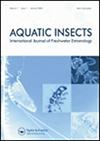美国乔治亚州中东部水生生境中水蝇科幼虫种群的时空格局
IF 0.5
4区 农林科学
Q4 ENTOMOLOGY
引用次数: 2
摘要
摘要我们对美国乔治亚州Ogeechee河(四年)和Carolina湾湿地(五年)的水生无脊椎动物群落进行了监测。通常罕见的神经翅目幼虫在这两个栖息地都相对常见(4-6%的样本发生率)。然而,每个物种都出现了不同的物种,河中的Climacia areolaris(Hagen,1861)和湿地中的Sisyra vicaria(Walker,1853)。在河流中,一龄灰蝶幼虫出现在整个夏季,与多伏性一致;一龄幼虫在二月也很丰富。在湿地中,只检测到一个单独的年度群体的S.vicaria。Ogeechee河的采样发生在20世纪80年代和2010年代,而晚龄乳晕C.areolaris在2010年代更为常见,这表明它是对环境变化的反应。博物馆对成年标本的数字化数据证实了对幼虫观察到的大多数酚学模式,以及最近乳晕梭菌丰度的增加。本文章由计算机程序翻译,如有差异,请以英文原文为准。
Temporal and spatial patterns for larval populations of Sisyridae (Neuroptera) in aquatic habitats of east central Georgia, USA
Abstract We monitored aquatic invertebrate communities in the Ogeechee River (four years) and Carolina bay wetlands (five years) in Georgia, USA. Typically rare, Sisyridae (Neuroptera) larvae were relatively common in both habitats (4–6% sample occurrence). However, different species occurred in each, Climacia areolaris (Hagen, 1861) in the river and Sisyra vicaria (Walker, 1853) in the wetlands. In the river, first instar C. areolaris larvae occurred throughout the summer, consistent with multivoltinism; first instars were also abundant in February. In the wetlands, only single annual cohorts of S. vicaria were detected. The Ogeechee River sampling occurred in the 1980s and 2010s, and late instar C. areolaris were more common in the 2010s, suggesting a response to environmental change. Digitised museum data of adult specimens corroborated most of the phenology patterns observed for larvae, as well as the recent increase in abundance for C. areolaris.
求助全文
通过发布文献求助,成功后即可免费获取论文全文。
去求助
来源期刊

Aquatic Insects
生物-昆虫学
CiteScore
2.00
自引率
25.00%
发文量
27
审稿时长
>12 weeks
期刊介绍:
Aquatic Insects is an international journal publishing original research on the systematics, biology, and ecology of aquatic and semi-aquatic insects.
The subject of the research is aquatic and semi-aquatic insects, comprising taxa of four primary orders, the Ephemeroptera, Odonata, Plecoptera, and Trichoptera but also aquatic and semi-aquatic families of Hemiptera, Coleoptera, and Diptera, as well as specific representatives of Hymenoptera , Lepidoptera, Mecoptera, Megaloptera , and Neuroptera that occur in lotic and lentic habitats during part of their life cycle. Studies on other aquatic Hexapoda (i.e., Collembola) will be only accepted if space permits. Papers on other aquatic Arthropoda (e.g., Crustacea) will not be considered, except for those closely related to aquatic and semi-aquatic insects (e.g., water mites as insect parasites).
The topic of the research may include a wide range of biological fields. Taxonomic revisions and descriptions of individual species will be accepted especially if additional information is included on habitat preferences, species co-existing, behavior, phenology, collecting methods, etc., that are of general interest to an international readership. Descriptions based on single specimens are discouraged.
Detailed studies on morphology, physiology, behavior, and phenology of aquatic insects in all stadia of their life cycle are welcome as well as the papers with molecular and phylogenetic analyses, especially if they discuss evolutionary processes of the biological, ecological, and faunistic formation of the group.
 求助内容:
求助内容: 应助结果提醒方式:
应助结果提醒方式:


